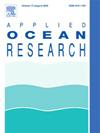Hydrodynamic loading analysis of an oscillating water column wave energy converter coupled with a land-fixed parabolic breakwater
IF 4.3
2区 工程技术
Q1 ENGINEERING, OCEAN
引用次数: 0
Abstract
The multi-functional integration of a parabolic breakwater and a Wave Energy Converter (WEC) can potentially focus wave energy and significantly enhance wave energy capture. However, the WEC is also subjected to the converging concentric wave interaction. The hydrodynamic loads associated with survivability are a critical concern that requires thorough investigation and improvement. This study focuses on the wave forces on an Oscillating Water Column (OWC) WEC coupled with a parabolic breakwater. Based on the time domain potential flow theory, a 2nd-order boundary element method was established to simulate the wave action with the multi-functional integrated system. Two carefully instrumented experiments analyzing the coupled parabolic breakwater and OWC device were developed to validate the numerical model. After that, the validated model is used to predict the nonlinear wave forces applied to the OWC by considering the effects of the environmental conditions and the geometric parameters. It is found that the resonant wave forces on the integrated system exceed three times the wave forces applied to an isolated device. The resonant frequencies of the surge and heave forces alternate at quarter-wavelength intervals. The 2nd-order wave force plays a significant role, even surpassing the contribution of the 1st-order waves in certain wave conditions. The pressure distributions on the OWC chamber wall are discussed, and the maximum pressure amplitude is located at the rear wall and near the still water level. The actual focal position associated with incident wavelength and direction notably influences the wave forces applied to the OWC device.
陆地固定抛物型防波堤耦合振荡水柱波能转换器的水动力载荷分析
抛物型防波堤与波浪能转换器(WEC)的多功能集成可以潜在地集中波浪能,并显着提高波浪能捕获。然而,WEC也受到辐合同心波相互作用的影响。与生存能力相关的水动力载荷是一个关键问题,需要进行彻底的研究和改进。本文研究了振荡水柱(OWC)与抛物型防波堤耦合作用下的波浪力。基于时域势流理论,建立了用多功能集成系统模拟波浪作用的二阶边界元方法。为了验证数值模型的正确性,进行了两次精心设计的实验,分析了抛物型防波堤与OWC装置的耦合。在此基础上,考虑环境条件和几何参数的影响,利用验证模型预测了作用于OWC的非线性波浪力。结果表明,作用在集成系统上的共振波力是作用在孤立装置上的波力的三倍以上。浪涌力和升力的共振频率以四分之一波长的间隔交替。二阶波力起着重要的作用,在某些波浪条件下甚至超过了一阶波的作用。讨论了OWC燃烧室壁面压力分布,最大压力幅值位于后壁面和静水位附近。与入射波长和方向相关的实际焦点位置显著影响施加在OWC器件上的波力。
本文章由计算机程序翻译,如有差异,请以英文原文为准。
求助全文
约1分钟内获得全文
求助全文
来源期刊

Applied Ocean Research
地学-工程:大洋
CiteScore
8.70
自引率
7.00%
发文量
316
审稿时长
59 days
期刊介绍:
The aim of Applied Ocean Research is to encourage the submission of papers that advance the state of knowledge in a range of topics relevant to ocean engineering.
 求助内容:
求助内容: 应助结果提醒方式:
应助结果提醒方式:


